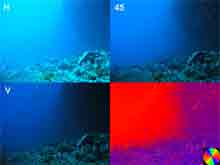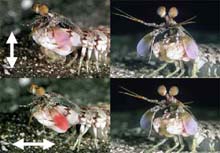
These four pictures show the Great Barrier Reef taken through a polarizing filter, which has been held in front of the camera horizontally, vertically, and at 45º. Click image for further detail and larger view.
Secret Communication Channels in the Ocean: Polarization Vision
Justin Marshall
Vision Touch and Hearing Research Centre
QBI
University of Queensland, Australia
Tom Cronin
Department of Biological Sciences
University of Maryland/Baltimore County
Sönke Johnsen
Assistant Professor
Duke University
People don't think much about polarized light. But when they reach for a pair of sunglasses on a boat or in a car to reduce water glare, they're reaching for a polarized filter. In these and other situations, having a polarized filter in front of the eye can make objects that are otherwise difficult to see more apparent.
Evolutionary Sunglasses
Not surprisingly, animals "invented" the same technology, only millions of years ago and through processes such as evolution. (This is often the case, when it comes to nature.) Many animals -- such as fish, insects, birds, crabs, and even shrimps -- have wonderfully well-tuned polarization vision to help them solve problems and perform their daily tasks. Scientists are currently studying these tasks and the ways in which "nature's technology" solves these problems.


Photographs of a mantis shrimp taken through polarizing filters rotated to be vertical (top) and horizontal (bottom). Note the color difference on the animal's paddles. Click image for more information and larger view.
The first thing to realize (and wearing a pair of polarized sunglasses can help with this) is that polarized light is prevalent in the world. It is reflected off shiny surfaces, such as water and leaves, in hazy environments, and even produced by animals themselves.
In recent years, scientists have been surprised to discover how many animals rely on polarization vision and the variety of possible uses for it. These include navigation (using polarized patterns in the sky), finding food, communicating with mates and rivals, and camouflage breaking.
Polarization in the Ocean
A fair bit of work has examined polarization vision (particularly in insects on land), but less attention has focused on the oceans and other aquatic environments. Using the Johnson-Sea-Link submersibles, the Operation Deep Scope team will study the type of polarized light found on the dive sites. We'll also look at the animals that live there to see if they have "secrets," such as those seen in the mantis shrimps.
For many ocean animals, sensing polarization may be even more important than sensing color. One possible use for polarization in the ocean (and elsewhere) is signaling: communicating with neighbors, rivals, and potential partners. Recent discoveries have shown that stomatopods, a sort of shrimp found on reefs around the world, use special body areas to communicate with polarized light. Only with polarizing filters can human eyes see these special areas.
Polarizing Shrimp
Equipped with polarizing filters, cameras have photographed mantis shrimps and revealed areas of the body that are thought to be used for "secret communication." They are visible only to animals that can see polarized light, and stomatopods are among the best in the animal kingdom. What are these red- colored, polarized areas used for?

Male (left) and female (right) mantis shrimps, showing a clear difference in polarizing signals. This method of communication -- visible only to animals that can see polarized light -- may be important for sex. Click image for more information and larger view.
The images give us a clue. The photographs on the right reveal clear differences when the filter is changed from a vertical orientation to a horizontal one. This means the male has the polarizing signal, while the female does not. The nature of the signal, therefore, may have something to do with sex.
Little is known about this "extrasensory" (to borrow a human term) sense; a world of discovery awaits. We need only to look around. There will be plenty of exciting things to find. Several clues suggest that many deep-sea animals use polarized light, and polarization vision more than color. The Johnson-Sea-Link submersibles will help us follow these leads and decode the secret mysteries of the deep. Every time we go down we find something new.























